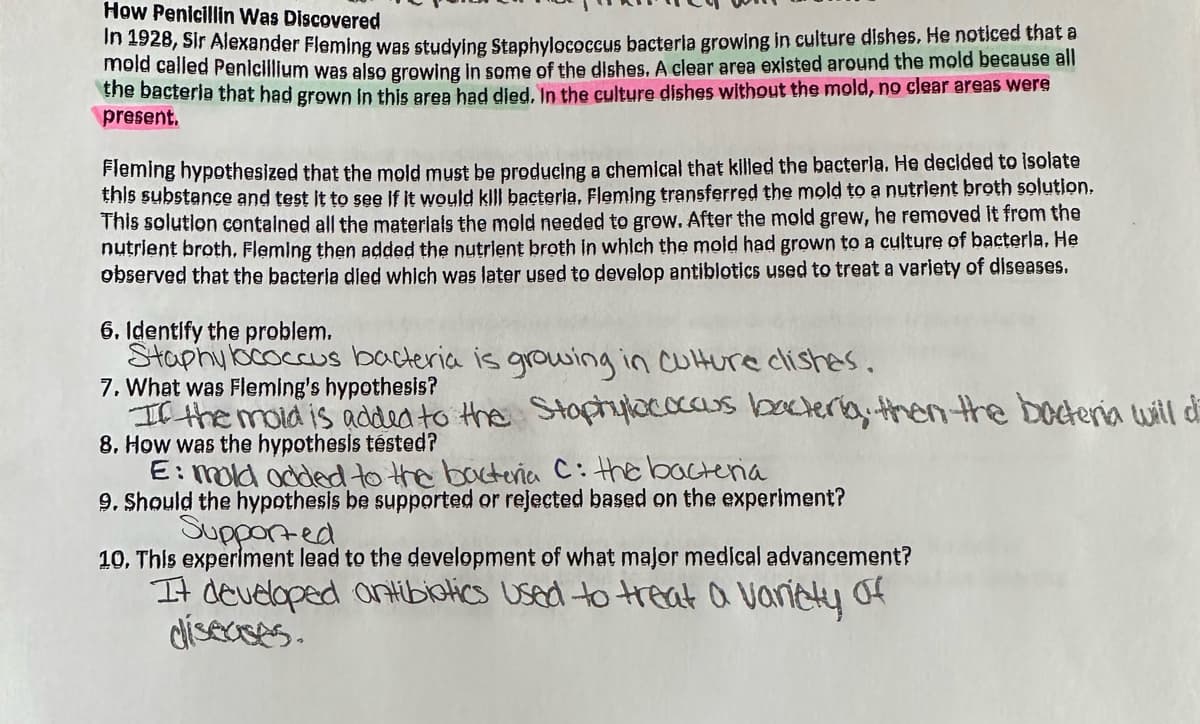How Penicillin Was Discovered In 1928, Sir Alexander Fleming was studying Staphylococcus bacteria growing in culture dishes. He noticed that a mold called Penicillium was also growing in some of the dishes. A clear area existed around the mold because all the bacteria that had grown in this area had died. In the culture dishes without the mold, no clear areas were present. Fleming hypothesized that the mold must be producing a chemical that killed the bacteria. He decided to isolate this substance and test it to see if it would kill bacteria. Fleming transferred the mold to a nutrient broth solution. This solution contained all the materials the mold needed to grow. After the mold grew, he removed it from the nutrient broth. Fleming then added the nutrient broth in which the mold had grown to a culture of bacteria. He observed that the bacteria died which was later used to develop antibiotics used to treat a variety of diseases. 6. Identify the problem. Staphylococcus bacteria is growing in Culture clishes. 7. What was Fleming's hypothesis? If the moid is added to the Staphylococcus bacteria, then the bacteria wi 8. How was the hypothesis tésted? E: mold added to the bacteria C: the bacteria
How Penicillin Was Discovered In 1928, Sir Alexander Fleming was studying Staphylococcus bacteria growing in culture dishes. He noticed that a mold called Penicillium was also growing in some of the dishes. A clear area existed around the mold because all the bacteria that had grown in this area had died. In the culture dishes without the mold, no clear areas were present. Fleming hypothesized that the mold must be producing a chemical that killed the bacteria. He decided to isolate this substance and test it to see if it would kill bacteria. Fleming transferred the mold to a nutrient broth solution. This solution contained all the materials the mold needed to grow. After the mold grew, he removed it from the nutrient broth. Fleming then added the nutrient broth in which the mold had grown to a culture of bacteria. He observed that the bacteria died which was later used to develop antibiotics used to treat a variety of diseases. 6. Identify the problem. Staphylococcus bacteria is growing in Culture clishes. 7. What was Fleming's hypothesis? If the moid is added to the Staphylococcus bacteria, then the bacteria wi 8. How was the hypothesis tésted? E: mold added to the bacteria C: the bacteria
Biology Today and Tomorrow without Physiology (MindTap Course List)
5th Edition
ISBN:9781305117396
Author:Cecie Starr, Christine Evers, Lisa Starr
Publisher:Cecie Starr, Christine Evers, Lisa Starr
Chapter13: Early Life Forms And The Viruses
Section: Chapter Questions
Problem 2CT
Related questions
Question
I need question number 8. What’s the experiment and the control group?

Transcribed Image Text:How Penicillin Was Discovered
In 1928, Sir Alexander Fleming was studying Staphylococcus bacteria growing in culture dishes, He noticed that a
mold called Penicillium was also growing in some of the dishes. A clear area existed around the mold because all
the bacteria that had grown in this area had died. In the culture dishes without the mold, no clear areas were
present.
Fleming hypothesized that the mold must be producing a chemical that killed the bacteria. He decided to isolate
this substance and test it to see if it would kill bacteria. Fleming transferred the mold to a nutrient broth solution.
This solution contained all the materials the mold needed to grow. After the mold grew, he removed it from the
nutrient broth. Fleming then added the nutrient broth in which the mold had grown to a culture of bacteria. He
observed that the bacteria died which was later used to develop antibiotics used to treat a variety of diseases.
6. Identify the problem.
Staphylococcus bacteria is growing in Culture clishes.
7. What was Fleming's hypothesis?
If the mold is added to the Staphylococcus bacteria, then the bacteria will de
8. How was the hypothesis tested?
E: mold added to the bacteria C: the bacteria
9. Should the hypothesis be supported or rejected based on the experiment?
Supported
10. This experiment lead to the development of what major medical advancement?
It developed antibiotics used to treat a variety of
diseases.
Expert Solution
This question has been solved!
Explore an expertly crafted, step-by-step solution for a thorough understanding of key concepts.
This is a popular solution!
Trending now
This is a popular solution!
Step by step
Solved in 2 steps

Knowledge Booster
Learn more about
Need a deep-dive on the concept behind this application? Look no further. Learn more about this topic, biology and related others by exploring similar questions and additional content below.Recommended textbooks for you

Biology Today and Tomorrow without Physiology (Mi…
Biology
ISBN:
9781305117396
Author:
Cecie Starr, Christine Evers, Lisa Starr
Publisher:
Cengage Learning

Biology Today and Tomorrow without Physiology (Mi…
Biology
ISBN:
9781305117396
Author:
Cecie Starr, Christine Evers, Lisa Starr
Publisher:
Cengage Learning